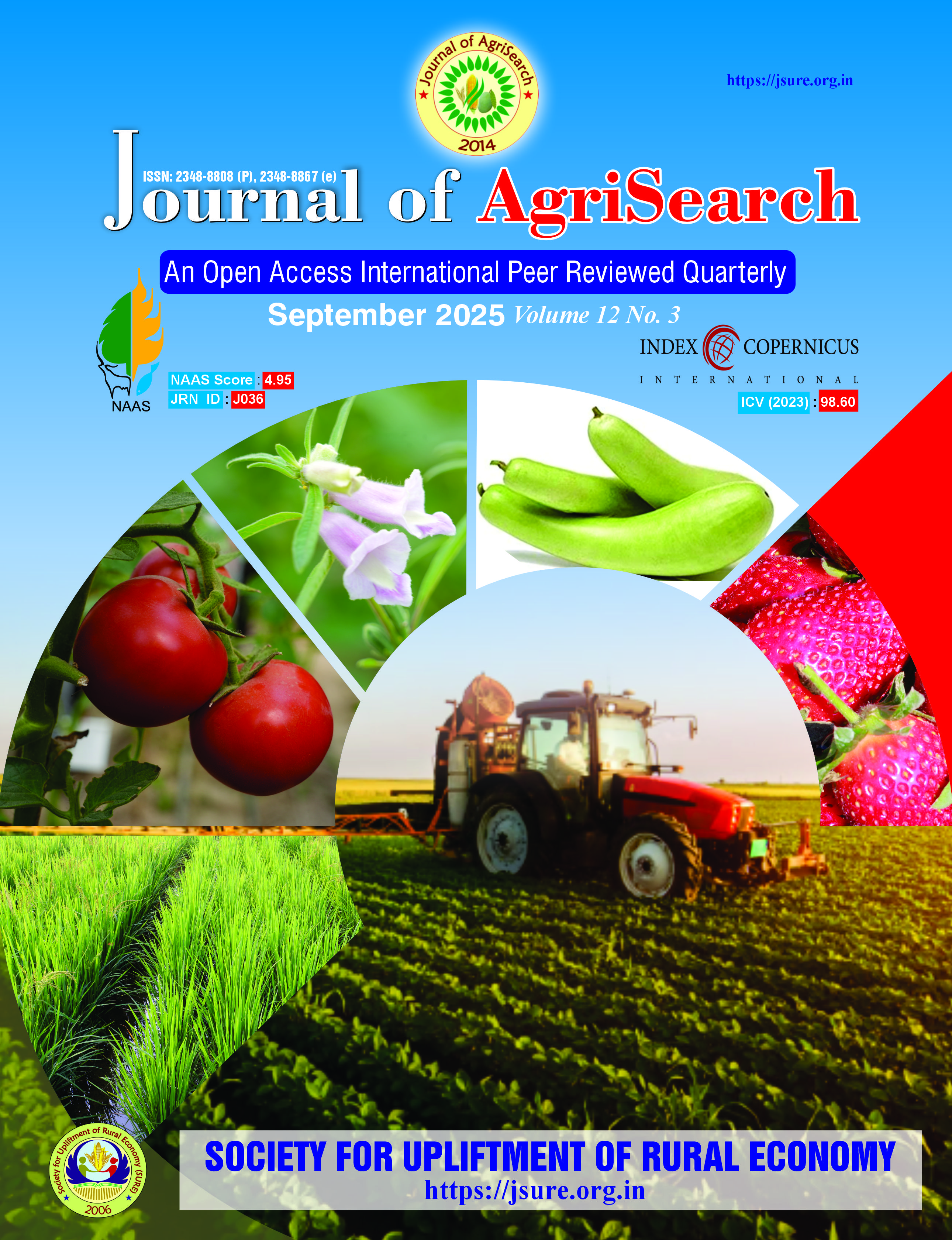Assessment of crop coefficients for tomato in temperate region of Kashmir
Tomato crop coefficients in Kashmir
DOI:
https://doi.org/10.21921/jas.v12i03.15247Keywords:
Reference evapotranspiration models, Crop coefficient, Drainage-type lysimeter, TomatoAbstract
A field experiment was conducted at SKUAST-K, Shalimar using a drainage-type lysimeter to determine the water requirement and crop coefficients (single and dual) for tomato (Solanum lycopersicum L.) under temperate conditions. Reference evapotranspiration (ET₀) during different crop growth stages was estimated using four empirical models and compared to actual crop evapotranspiration (ETc) measured via the lysimeter. Model performance was assessed using statistical indicators including Nash–Sutcliffe Efficiency (NSE), root mean square error (RMSE), and correlation coefficient (r). Results indicated a "Satisfactory" to "Very Good" agreement between computed and observed ETc values. A Z-test revealed no statistically significant differences at the 5% level between lysimeter-measured ETc and values estimated by the four models, affirming their applicability. Among these, the FAO Penman-Monteith model showed the closest agreement with lysimeter data, with R² values of 0.88, 0.93, 0.91, and 0.92 across initial, development, mid, and late stages, respectively. The single crop coefficient (Kc) values determined were 0.54 (initial), 0.85 (development), 1.04 (mid-season), and 0.62 (late). Dual crop coefficients [Kcb (basal crop coefficient) + Ke (soil evaporation)] were 0.52, 0.83, 1.01, and 0.59, respectively. These findings underscore the lysimeter's effectiveness for calibrating ecohydrological crop evapotranspiration models and provide critical data for efficient irrigation planning in the temperate regions of Kashmir.
References
Allen R G, Pereira L S, Howell T A and Jensen M E. 2011. Evapotranspiration information reporting: II. Recommended documentation. Agricultural Water Management 98(6): 921-929.
Allen R G, Pereira L S, Raes D and Smith M. 1998. Crop evapotranspiration-Guidelines for computing crop water requirements-FAO Irrigation and drainage paper 56. FAO, Rome, 300(9): D05109.
Djaman K, Balde A B, Sow A, Muller B, Irmak S, N’Diaye M K, Manneh B, Moukoumbi Y D, Futakuchi K and Saito K. 2015. Evaluation of sixteen reference evapotranspiration methods under sahelian conditions in the Senegal River Valley. Journal of Hydrology: regional studies 3: 139-159.
Doorenbos J and Pruitt W O. 1975. Revised (1977) Crop water requirements. Irrigation and Drainage Paper no. 24, FRO, Rome.
Hargreaves G H and Samani Z A. 1985. Reference crop evapotranspiration from temperature. Applied engineering in Agriculture 1(2): 96-99.
Howell T A, Schneider A D and Jensen M E. 1991. History of lysimeter design and use for evapotranspiration measurements. Lysimeters for evapotranspiration and environmental measurements 1-9.
Jagtap S S and Jones J W. 1989. Stability of crop coefficients under different climate and irrigation management practices. Irrigation Science 10(3): 231-244.
Kang S Z, Davies B, Shan L and Cai H. 2003. Water-saving agriculture and sustainable use of water and land resources. Shaanxi Science and Technology Press, Xian, PR China.
Kumar K, Gupta S C, Baidoo S K, Chander Y and Rosen C J. 2005. Antibiotic uptake by plants from soil fertilized with animal manure. Journal of environmental quality 34(6): 2082-2085.
Muniandy J M, Yusop Z and Askari M. 2016. Evaluation of reference evapotranspiration models and determination of crop coefficient for Momordica charantia and Capsicum annuum. Agricultural Water Management 169: 77-89.
Naidu D and Majhi B. 2019. Reference evapotranspiration modeling using radial basis function neural network in different agro-climatic zones of Chhattisgarh. Journal of Agrometeorology 21(3): 316-326.
Pandey Y, Dadhich S M and Singh P K. 2023. Estimating Irrigation scheduling for Cabbage (Brassica oleracea) using the CROPWAT 8.0 Model in the Temperate Region of Kashmir. Journal of Community Mobilization and Sustainable Development 18(3): 1031-1038.
Pandey Y, Mehraj N, Dadhich S M, Akhtar Y and Lateef Z. 2023. Estimation of Crop-coefficients and Evapotranspiration of Field Pea (Pisum sativum L.) Using Lysimeter and Empirical Models under Temperate Climate. International Journal of Environment and Climate Change 13(11): 2751-2758.
Thornthwaite C W. 1948. An approach toward a rational classification of climate. Geographical review 38(1): 55-94.
Wright J L. 1982. New evapotranspiration crop coefficients. Journal of the Irrigation and Drainage 108(1): 57-74.
Downloads
Published
Issue
Section
License
Copyright (c) 2025 Yogesh Pandey; Zubair Ahmad Mir, SM Dadhich; Bint Nazir N

This work is licensed under a Creative Commons Attribution-NonCommercial-NoDerivatives 4.0 International License.
Publisher and Authors

